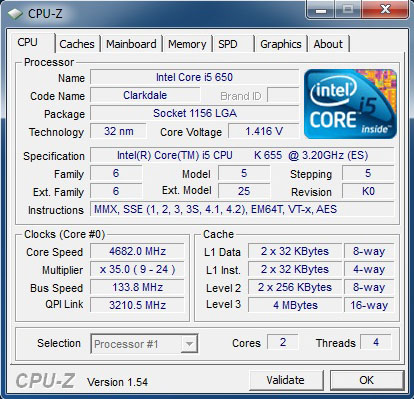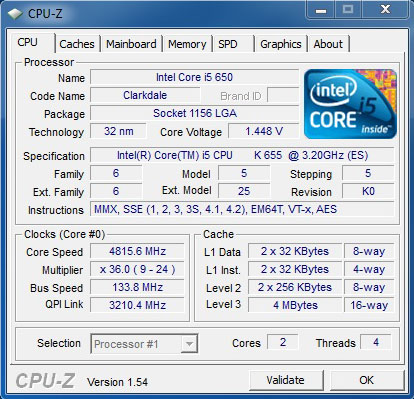Intel Core i7-875K And Core i5-655K Battle Beyond 4 GHz
Do you like the idea of an unlocked clock multiplier, but don't want to pay $1,000 for an Extreme Edition? Intel's K-series CPUs bring overclocking down to the mainstream. The question is: can these scalable parts keep up with AMD's Black Edition CPUs?
Intel: 4.8 GHz On Air? Sure!
But that’s not the only curveball we’re throwing. It’d really be pointless to benchmark either of these new CPUs at their stock frequencies. Nobody pays a premium for an unlocked processor only to run it at the same speed as a couple of less expensive models. Instead, we’re pushing both chips as far as they’ll go on air (cooled by Noctua’s NH-D14, that is). The point here is to overclock via the unlocked multipliers, testing to see just how much headroom is available from Intel’s 45 nm and 32 nm nodes.
Additionally, we’re adding a pair of Black Edition parts—the Phenom II X4 965 and Phenom II X6 1090T. The two AMD processors are priced at $185 and $310, respectively. Though Intel’s offerings are more expensive ($216 and $342), the quad-core Core i7-875K goes up against the six-core Phenom II X6 1090T fairly well, while the dual-core Core i5-655K takes on the quad-core Phenom II X4.
Right out of the gate, AMD has the advantage on cost, so Intel has to prove itself in performance beyond 4 GHz.
Core i7-875K
Lynnfield’s “limitations” are fairly well-known, so it was hardly surprising to see the Core i7-875K reach a stable 4.13 GHz before exhibiting a bit of instability.
We were actually able to run most tests at 4.26 GHz before determining that this CPU just couldn’t take the heat over the long term. Using Patrick’s Core i5 clock rate guide as a starting point, we got up to 1.5V before backing down and deciding 4.26 GHz just wasn’t going to happen. Naturally, heat was the enemy here, and CoreTemp saw us consistently butting up against the processor’s 99 degree Tj limit. Of course, it didn’t help that the fourth core ran particularly hot, cresting the limit as the other cores were just hitting 90 degrees.
For all testing, Turbo Boost was disabled, giving us a static overclock. Hyper-Threading is left enabled, and Enhanced SpeedStep is on as well.
Get Tom's Hardware's best news and in-depth reviews, straight to your inbox.
Core i5-655K
I was frankly most excited to work with the Core i5, a $216 part manufactured at 32 nm and set to run at 3.2 GHz by default. We’ve already had a couple of Clarkdale-based voltage-related fatalities here in the lab, so I wanted to exercise at least some caution. But ambition got the best of me and I ended up testing up to 1.45V—right about where Don lost his Pentium G6950.
Nevertheless, I was able to boot at 4.93 GHz. On air. Without killing the chip. I managed to run a number of our benchmarks at 4.8 GHz, but crashing in 3ds Max 2010, for instance, compelled me to drop another notch to 4.66 GHz. Still, an extra 1.46 GHz isn’t bad (at a reduced voltage of 1.4165V).
Again, Turbo Boost was turned off for this one, with Hyper-Threading and SpeedStep turned on. As with the Core i7-875K, 8 GB of DDR3 memory ran at 1,066 MT/s with 7-7-7 timings. Really, the beauty of these unlocked parts is that you don’t have to worry about modules able to accommodate tons of headroom. Of course, if you have enthusiast-class DDR3, unlocked memory ratios let you scale data rates up and down (though there’s really little reason to go beyond the official 1,333 MT/s these chips support).
Current page: Intel: 4.8 GHz On Air? Sure!
Prev Page So Many Ways To Exceed 4 GHz Next Page AMD: Two CPUs At 4 GHz-
Known2Bone wow now that is some serious over-clocking... and here i am trying to push my 955 up past 3.93. i would have liked to see some liquid cooling tossed in to spice things up and maybe one more 5970... great job Chris!Reply -
cangelini Known--I'll talk to Thomas about getting some of that going in his next System Builder Marathon piece. He loves liquid cooling =)Reply -
Stardude82 Intel did release the E6500K for the LGA 775, but only in Asia.Reply
The only good thing here is that these chips will probably ship with heat sinks that don't suck and a good price drop for the i7 870. Otherwise, who cares, FSB stability on decent P55 boards has not been a problem. What the socket really needs from Intel is a better chip-set, not easier overclockers. -
nurgletheunclean 9. All prize winners are responsible for taxes and other surcharges on the prizes they win.Reply
1099'd for $1499? I hate how contest prizes all have full MSRP on everything. Even if you win it end up costing you $500+ in taxes. -
SpadeM Intel makes good cpus, that's a given. Their problem lies in the pricing of such chips. I mean if you could buy a processor because you want to overclock it then the locked but cheaper one is as good as the unlocked one. Sure, it's more difficult, but I for one love a challenge.Reply
Also, as a side note, I do have a problem with the benchmarks and more accurately with the conclusion you extracted from them. Who in their right mind would buy a processor, overclock it, and then do iTunes all day ... I mean come on, there's more to life then music ripping. What I'm saying is that the benchmark section SHOULD be remade entirely. Same old tests, that I could anticipate the outcome of every time, isn't a very compelling way to make a point. I do appreciate the game section though, at least i saw a new title. -
jecastej Finally, very good news for serious desktop processing power that wont leave me with an empty wallet. The 875K is going to be my next CPU for 3D modeling and rendering. I hope it will keep me entertained for a while =)Reply
Don't get me wrong but I was getting bored with the tiny world of ARM and Tegra and on the other side of the spectrum the hexacores and dual Xeons were far and away for my budget. -
anamaniac sarsoftLGA 1366 i7 hopefully will be available soon. GRRRRRRRRR........On Xtremesystems.org, I just read about a guy reaching 4.644GHz on air with his i7 930. Granted, he has a great chip, but by no means is a unlocked multiplier needed for high overclocks.Reply
If I were to build a new PC, the 1090T/1055T would be very complelling.


